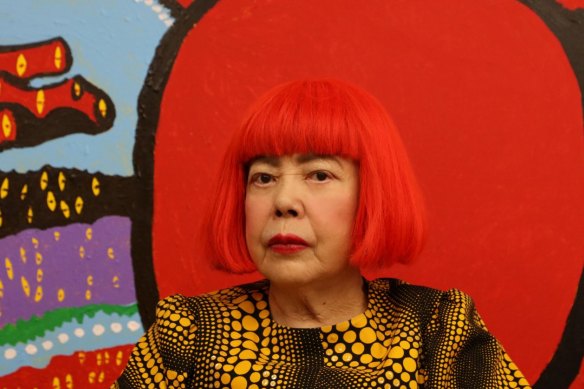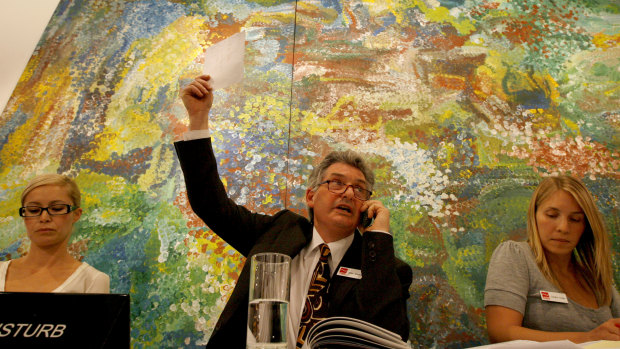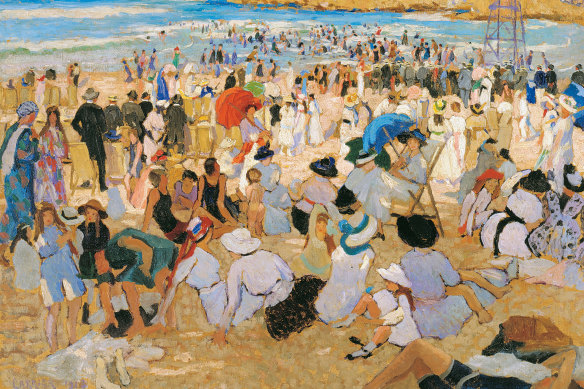This was published 3 years ago
Blind viewing shows how female artists are undervalued
By Jenna Price
Women make up a tiny proportion of the international art auction market, says art historian Griselda Pollock, keynote speaker at this week's NGA's Know My Name conference. Last year, the international art world was scandalised when two journalists, Julia Halperin and Charlotte Burns of Artnet, revealed work made by female artists accounted for just over two per cent — US$4 billion — of the entire market over 11 years.
Five international stars made up just over half that money: Yayoi Kusama, Joan Mitchell, Louise Bourgeois, Georgia O’Keeffe and Agnes Martin. As Pollock put it: “All white and dead save Yayoi Kusama, who is Japanese."
Pollock says that the limited market is a direct result of decisions made by museums and galleries. “There is an intimate relation between financial and symbolic value. If the work of women is not valued by scholars and curators art historically, the market reflects that low estimation.
“And if the work is not valued by the market, investors and collectors, the museums do not value it either and no one wants to publish books on the artists,” she says.

Yayoi Kusama, in front of Life is the Heart of a Rainbow (2017), is one of five women who dominate sales by female artists.Credit: Ola Fine Arts/Victoria Miro/David Zwirner
Renee Adams, professor of finance at the Said Business School at Oxford, has done the numbers. In a paper she wrote in 2017 (but so far not published in the traditional finance academic journals despite having won awards), she and her colleagues made a remarkable finding.
"We looked at auction prices, secondary market art prices. And what we show is there's a roughly 40 per cent discount for paintings painted by women relative to paintings painted by men."
They used 1.5 million auction transactions in 45 countries and documented a 47.6 per cent gender discount in auction prices for paintings. Adams says a traditional economist would respond to that by saying that the market is efficient: "And that this must mean the paintings are worse."
But what the researchers found made the results even more compelling: "In countries where there is more gender inequality, the discount is bigger . . . if it was about the quality then culture wouldn't matter."
But they also performed an experiment. They showed participants five paintings by women and five paintings by men. Nothing high end, nothing too famous. Participants were asked to guess the gender of the artist just by looking at a painting. No names, no provenance. Participants couldn't. As the researchers concluded: "Women's art appears to sell for less because it is made by women."
Of all the arts sectors, Adams says visual arts is the least transparent. While auction data is freely available, the primary market is opaque. And that's just part of the problem: "Many museum directors are male and there's a whole structure in place, not open to competition, not transparent. It entrenches the current culture."
'Participants were asked to guess the gender of the artist just by looking at a painting. Participants couldn't. '
Business school professor Renee Adams
But Annette Larkin, Sydney art dealer and valuer, says she sees a shift in the Australian market. There is some focus on how women fare on the auction scene. That's particularly true of the work of Emily Kame Kngwarreye, whose 1995 work Earth's Creation sold for $2.1 million in 2017 — the highest price paid for work at auction by an Australian female artist following a record-breaking sale at $1.05 million just 10 years earlier.
"Now there is more hype around the work, when auctions get written up, there is a focus on how women artists are faring," says Larkin.

In the first groundbreaking auction for Emily Kame Kngwarreye's Earth's Creation in 2007, Adrian Newstead of Lawson Menzies bids for a would-be phone buyer.Credit: Dallas Kilponen
In the past, periods of Australian art have been defined by the men who painted. That's changing, too. Ethel Carrick Fox sells for more than her husband, Emanuel Phillips Fox. Clarice Beckett was a follower of Max Meldrum — now her work sells for more than his.
"Meldrum would be turning in his grave," says Larkin.

Now outselling her once more famous husband: 'Manly Beach - Summer is Here' (1913) by Ethel Carrick Fox
There are some collectors who make the specific decision to collect women's art. From 1974, Sheila Cruthers assembled a notable group of art works by women, which she gifted to the University of Western Australia in 2007. The collection now numbers over 700 works and is the largest standalone collection of women's art in Australia.
Norman Feather, now an emeritus professor from Flinders University, went along to an auction on Unley Road in the early '70s and admired a little painting of a scene in Morocco, signed BD. He bought it for a very small sum. He later discovered the artist was Bessie Davidson, who had exhibited at the French Academy in the early parts of the 20th century. Feather took advice from an antique dealer who believed work by female artists would increase in economic value over time.
"Over time I came to see more and more there was really good work there that wasn't acknowledged. That was reinforced by Ned Roberts [the antique dealer] and over time, I was able to learn more about women artists."
Feather says that he no longer attends auctions. His wife died a few years ago and she too was keen on buying the work of women.
"Like most women these days, she was a little bit feminist and had the feeling that women had been under-represented and deserved a better go.
"I was supportive of that and believe that to be the case as well."
One exceptionally private Sydney collector says she only collects women’s art.
"The reasons are pretty obvious to any thinking woman or artist. Women are under-represented, under-valued and under-supported. And quickly forgotten even if they have a brief moment of success or fame. And a lot of men simply don’t like what women paint or depict. Women just need to support other women."
At the end of 2018, Renee Adams presented her paper Is Gender in the Eye of the Beholder at the Art Students League of New York. There were a number of female artists in the audience. She says that one artist came up to her at the end and said, "from now on, I should sign my paintings with a male name instead of a female name."